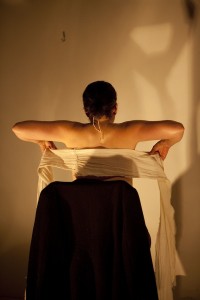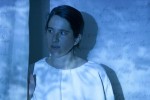Heather Hermant in ribcage, which will be at the Firehall Arts Centre March 3-8. (photo by Tim Matheson)
As a graduate student, Toronto spoken word artist Heather Hermant took a workshop taught by Diane Roberts, a former artistic director of Vancouver’s urban ink productions. Roberts asked her students to research and embody an ancestor, and Hermant chose her great-great-grandmother Riva. The process eventually led to the multimedia theatrical project ribcage: this wide passage, which comes to Vancouver’s Firehall Arts Centre next month.
ribcage centres on Esther Brandeau, a Jewish woman who, posing as Jacques La Farge, a male Christian laborer, came to Canada from France in 1738. Said to be the first Jew to ever set foot in Canada, she was discovered, interrogated and later deported when she wouldn’t convert to Catholicism. Writes Hermant in a 2013 Canadian Theatre Review article, “Riva stepped aside as I followed an archival labyrinth – in Ottawa, Montreal and Quebec City, and in every place that Brandeau was purported to have worked as a young man over five years across France.”
The 2005 workshop was Hermant’s introduction to Roberts’ Personal Legacy process and, writes Hermant in the CTR, it is “the first performance to move from idea to production through the Personal Legacy process. It was workshopped and presented in Vancouver as part of the 2010 Tremors Festival. The full production premièred at Le MAI in Montreal in October 2010.” A French version of the performance has also been created: thorax: une cage en éclats, translated by Quebec performer and scholar Nadine Desrochers.
“I began as a spoken word performer, and thought I would approach this performance as a series of spoken word pieces. In other words, what I usually did but longer, more material,” said Hermant, who is now a performer across several genres, as well as being a curator, scholar and educator. “When I began to work, I discovered that spoken word poetry as I knew it would not do it with this story. Partly, this had to do with language. I was working with French language archives and yet I write in English. On top of or because of that, a lot of the material I was creating was physical – gesture, movement. A lot of it was video. These were things that were unexpected and new for me since what I thought I was aiming for was spoken word poetry. So, it was a bit scary.
“But, in studio work with Diane Roberts, who directs the show and who has been there from the beginning of its creation, this is where you start. Starting with movement, for example, is a key to storytelling. According to Diane, working from the body first forces a kind of honesty that is difficult to achieve when using language. Luckily, it was in a performance class with Diane where I first discovered the story of Esther Brandeau. Words came late, which is odd for a poet, but in a way this was part of the story. It was as if an impossibility to fully know stood at the centre, and required all sorts of different approaches to do just that: to approach the story, which demanded its own form.”
As her research continued, Hermant realized the production would need a musical dimension. “I began to hear live fiddle and see live mixed video installation. When we came together in collaboration with composer/fiddle player Jaron Freeman-Fox, he composed most of the material in studio (as in dance/theatre studio) with me, working from my movement and the rhythms of some of my text.”
The video in the production, she explained, derives from her research in various countries, “often collected as a way of journaling” her work. “A bunch of the video material is from site-specific reenactments filmed by Melina Young. VJ Kaija Siirala and I worked in studio together to make all this eclectic rich footage into a mixed installation concept…. The video installations operate as a kind of memory space, their own kind of eye on what’s transpiring. Interdisciplinarity in this piece allows for different witness positions to come through, I think. Different ways of looking.”
Hermant doesn’t consider ribcage a play. “It is somewhere between spoken word and storytelling, physical theatre, a series of interdisciplinary tableaux, a performance installation, all of it in a theatre. I just understand it all as poetry, regardless of whether words are involved or not.”
As diverse as are the performance aspects, so too are ribcage’s themes: identity and sexuality, belonging and personal history, established roles and genders as well as rebellion against them. “Thematically,” explained Hermant, “ribcage is a confrontation with the meaning of history and how we know the past. It is about how we work and translate across languages, eras and bodies. It confronts holes and gaps and unknowns in any written record, and works from a place of longing, desire to know and to feel belonging and to understand the present moment. I created this piece because I was compelled by the personal resonances I found with the story of Esther Brandeau…. My show is about my own ancestral and personal histories, and the journey of my research, as much as it is about the story of Esther Brandeau/Jacques La Fargue. All of these stories enter into ribcage: this wide passage, through the different media and forms that I integrate.”

Hermant noted that women passing as men, “especially in Europe in the 17th and 18th centuries … was far more common than the exceptional cases seem to suggest. In addition to the most popular assumption and representations – that the primary motive for women who passed as men was to follow their male lovers, which circulates through pop culture across many eras, and of which there are indeed many documented historical examples – there were many cases of passers who did so out of economic necessity, there were many cases of passers who did so in order to partner with women, or a combination of these.”
For Hermant, the historical record must be regarded with care. “The important thing to me is to ask how a story is recorded, how it comes to us, what are the stakes for the person outed. In other words, it is vital to read askance and to distrust the document, even as the document gives us the story.
“What is particularly interesting for me in this case,” she continued, “is this is purportedly a case of a female passing as a male and a Jewish person passing as a Christian. I like to call this person a multicrosser. I find we need to challenge the assumption that passing is simply a ruse. Classical literature is full of titillating stories of passers, titillating primarily for straight male audiences. My queer positionality perhaps makes more available to me a knowledge that changing gender can be a profoundly sacred process, that sexuality may or may not have anything to do with it, and that queerness as many of us know ourselves today has history. This doesn’t mean sameness across time. That last sentence is vital. In other words, how people understand themselves today and the terms through which they do so are not the same as how people understood themselves 200 or 300 years ago. This is an inherent challenge to reading, understanding and representing things as they were long ago. It’s partly why I have not chosen to create a work that takes place only contained in a long ago era.”
Describing ribcage as “a midrash on the archive,” Hermant explained, “It’s a meditation, a questioning, a digging in deep into the idea of archive, into archives themselves, into memory and telling, loss, desire, the written word and its troubles, a need to understand belonging, compelled by questioning and not by a need or a belief in the possibility or utility of resolution. In fact, to me, such a stance is an ethical stance, and some might say a profoundly Jewish one – though of course not exclusively so – i.e. the imperative of the question. So, yes, of course, my Jew-ish-ness (hyphenation intentional) is important to me and to my show. ‘Jewishness,’ however defined … and a grappling thereof, informs the piece profoundly. As does my non-Jew-ish-ness, my queerness, my experiences of gender, my feminist leanings, my francophone ancestry, my being a settler ally working with an aboriginal and intercultural theatre company on unceded Coast Salish territory, my work as a scholar in gender studies, colonial history and historiography, my teaching, my concern for land and water…. The list goes on. It is all important to me, all profoundly inform the show, and none of these is mutually exclusive!”
And these are not the only aspects informing the show. “Dealing with difficult histories does not preclude humor, playfulness or joy. In fact,” said Hermant, “these are essential precisely for dealing with difficult histories. I choose the topics I choose – or they choose me – because I feel a responsibility and a call to do so. And because, very simply, they compel me.”
ribcage, produced by urban ink productions, will be at the Firehall Arts Centre March 3-8. Freeman-Fox’s original music will be performed by Vancouver musician Elliot Vaughan.
Olga Livshin is a Vancouver freelance writer. She can be reached at [email protected].

